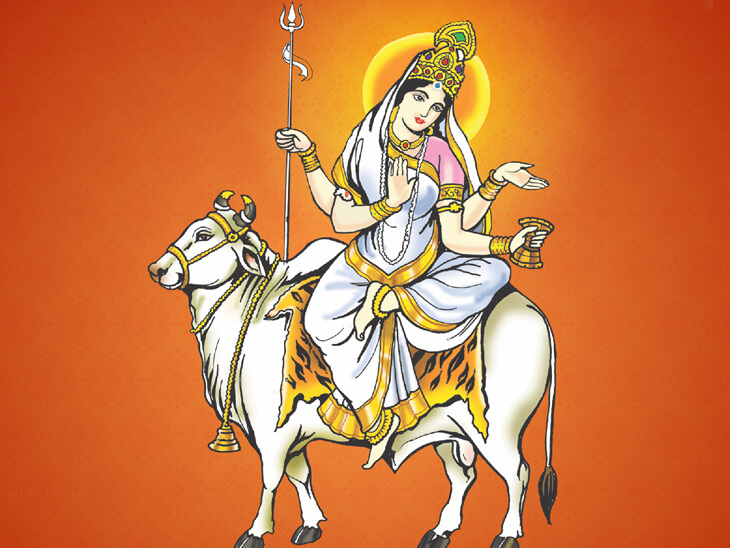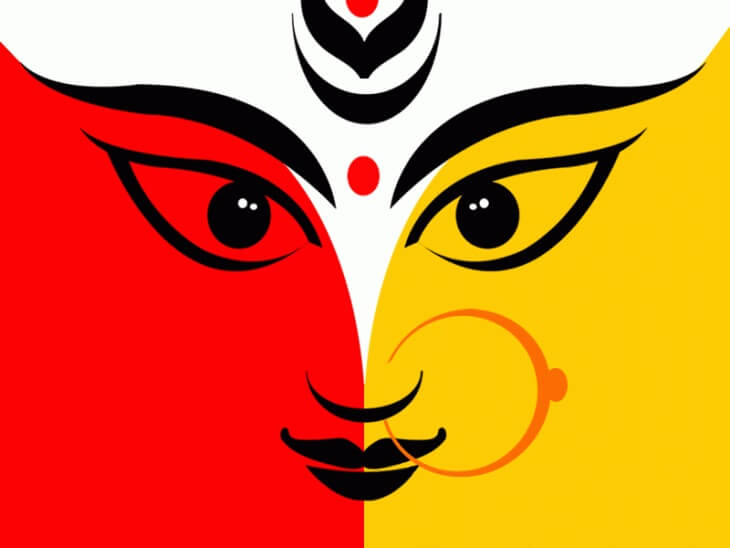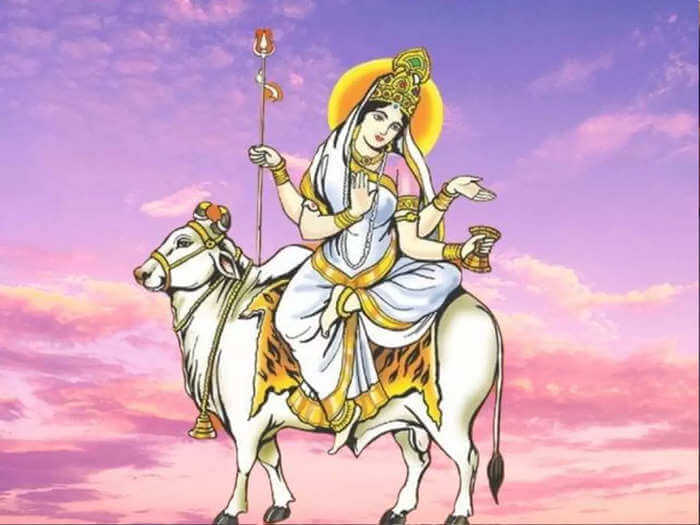
The eighth form of Mahadevi is the mother goddess Mahagauri. She is worshipped on the eighth day of Navaratri. Her name is formed by two words – Maha meaning great; and Gauri meaning bright. This in other words means a person who is extremely bright like the moon. Maa Mahagauri is considered to be the most beautiful avatar of Navadurga and anyone who worships her is blessed with prosperity, health, and wealth.
Goddess Mahagauri appears in many forms such as Durga, Parvati, or Kali. Her mission is to protect good people and punish those who perform evil deeds. Goddess Mahagauri has the power to fulfil all the desires and remove all sufferings in the life of her devotees.
Mahagauri is often depicted with three eyes in her form as Durga. The third eye represents her higher perception and intuition, which she uses to see beyond the material world and into the spiritual realm. It is also believed to represent her ability to destroy ignorance and darkness with her powerful gaze.
In some depictions, Mahagauri is shown with only two eyes, with the third eye symbolically represented as a dot or bindi on her forehead. However, the three-eyed form is more commonly seen in her representations.
Mahagauri’s three eyes are also associated with the three gunas or qualities of nature, namely sattva (purity and knowledge), rajas (activity and passion), and tamas (darkness and ignorance). The third eye represents the ability to transcend these gunas and attain a state of pure consciousness and enlightenment. Mahagauri’s three eyes represent her divine power, wisdom, and ability to see beyond the physical realm.

Goddess Mahagauri – one of the nine forms of the Hindu goddess Durga is usually depicted with four hands, holding a trident (trishul) and a tambourine (damaru) in her upper hands, while her lower right hand is in a gesture of blessing (abhaya mudra), and her lower left hand is holding a lotus flower (padma).
The trident symbolizes her power to destroy evil, while the tambourine represents her creative force that generates sound and rhythm. The lotus flower represents purity and enlightenment, and the gesture of blessing signifies her protection and guidance to her devotees.
Mahagauri’s appearance is also associated with the white colour, which symbolizes purity and peace. She is depicted wearing white clothes and riding a bull or a white elephant. Mahagauri blesses her devotees with purity, peace, and spiritual growth. She removes the impurities of their mind and body and helps them attain a state of inner peace and harmony.
According to Hindu mythology, Mahagauri was the daughter of King Himalaya and Queen Maina and was called Parvati. Princess Parvati grew up to be a good girl who desperately wanted to marry Lord Shiva. So she performed intense penance to win Lord Shiva’s love and affection. She lived in the forest, meditating and performing austerities for years. Finally, Lord Shiva was impressed by her devotion and accepted her as his wife.
After marriage, Parvati lived with Lord Shiva in the Himalayas and came to be called Gauri, due to her fair complexion. However, over time, physical appearance becomes dark and dishevelled. Seeing this Lord Shiva asked her to bathe in the holy Mansarovar Lake to restore her beauty. She did as told and regained her radiant white complexion by bathing in the holy water of Lake Mansarovar which had the power to purify and cleanse the body and mind.
Another slightly different version states that there were two demons Shumbha and Nishumbha who could only be killed by a virgin. So Brahma, repeatedly called Parvati “Kali” for no reason, in a mocking way. Parvati was hurt by this teasing, so she performed severe penance to please Brahma and request him to grant her a golden complexion.
Brahma explained his inability to do so and instead requested her to slay the demons Shumbha and Nishumbha two powerful demons who had defeated the gods and were causing havoc. Goddess Mahagauri or Parvati agreed to kill Shumbha and Nishumbha and restore peace and order to the world.

Meanwhile hearing of her beauty Shumbha and Nishumbha proposed to marry Goddess Mahagauri who not only refused their proposal but instead challenged them to a battle. Shumbha and Nishumbha, accepted the challenge and the battle went on for days, with no one gaining the upper hand. Finally, Mahagauri transformed into Kali which was her fiercest form and not only defeated the demons’ but also killed their commanders.
Eventually, Shumbha and Nishumbha were killed by Mahagauri’s trident. Goddess Mahagauri’s victory over Shumbha and Nishumbha is celebrated during the Navaratri festival, particularly on the eighth and ninth days which are dedicated to Mahagauri and Kali respectively. It is believed that by worshipping Mahagauri and Kali during Navaratri, one can overcome their fears and obstacles and attain victory over their enemies.
There is another exciting story about how Goddess Mahagauri transformed herself into Chandraghanta an incarnation of goddess Durga – known for her bravery and strength.
The story of how Chandraghanta killed the demon Dhumralochan goes as follows. According to legend, Mahishasura defeated the Gods who sought the help of the goddess Durga who appeared before them in the form of Chandi or Chandraghanta and promised to defeat Dhumralochan.
Accordingly, Devi Mahagauri mounted her tiger and challenged Dhumralochan and a fierce battle ensued. Dhumralochan who had the power to change his form transformed himself into a buffalo and charged towards Devi Chandraghanta who with her divine strength lifted the demon buffalo with one hand and beheaded him with the sword in the other hand. The demon’s body fell to the ground, lifeless.
The gods were so happy due to Chandraghanta’s victory over Dhumralochan that they showered her with flowers and praises. Chandraghanta’s victory over Dhumralochan is celebrated during the Navaratri, particularly on the third day. It is believed that by worshipping Chandraghanta during Navaratri, one can overcome fears and obstacles and attain strength and courage like her.
Navaratri Day 8: Significance
The eighth day is known as Ashtami or Durga Ashtami. It is one of the most important days of Navaratri and marks the victory of good over evil. It is believed that on this day, Goddess Durga defeated the demon Mahishasura, who symbolizes ignorance and ego. Hence on Ashtami, devotees worship Goddess Durga or Mahagauri and chant mantras while performing special puja rituals.
Ashtami is also celebrated as Kanya Puja, where young girls are worshipped as manifestations of Goddess Durga and her divine feminine energy. The girls are offered food, new clothes, and gifts, and their feet are washed as a symbol of respect and gratitude.
It has been told in Devi Bhagvat Purana that the eighth day’s worship reflects the basic nature of Maa Durga and Mahagauri always resides with Mahadev as her consort, hence one of the names of Maa is Shiva. Worshiping Mahagauri awakens the Somchakra and by her grace, only every impossible task is accomplished.
According to Devi Bhagwat Purana, when Parvati the daughter of King Himalaya was only 8 years old she realized the events of her previous birth and hence started penance to get Lord Shiva as her husband. That’s why Mahagauri is worshipped on the eighth day of Navratri. This is her Annapurna Swaroop. Goddess Mahagauri loves singing and music and is riding on a white bull.
Also Read:
The Legend of Maa Chandraghanta
The Legend of Maa Brahmacharini
Colour
According to Devi Bhagwat Purana, all of Goddess Mahagauri’s clothes and ornaments are white hence she is also called Shwetambardhara and is given the status of being the presiding deity of wealth, prosperity, happiness and peace.
Puja Vidhi:
Traditionally there is a practice of worshipping the girls on Ashtami. However, some people worship the girl child even on the day of Navami. But, the best day to worship the girl child is on the 8th day or Ashtami. It is best if the number of girls is 9, otherwise one can worship two girls also. There should also be a langura (Batuk Bhairav) along with the girls.
The ritual is to call the girls home and apply kumkum tika after washing their feet. After that worship and offer them halwa-gram, poori etc. and give them Dakshina according to one’s ability. After this, touch the feet and bid farewell to the girls, singing praises of the mother.
Bhog:
It is auspicious to offer sweets made of coconut to the mother. According to legend offering sweets made of coconut and sugar to Maa Mahagauri makes her happy and fulfills all their wishes.
Favourite Flower
Night blooming jasmine
Mantra
ॐ देवी महागौर्यै नमः॥
Om Devi Mahagauryai Namah॥
Hail Devi Mahagauri
Prarthana
श्वेते वृषेसमारूढा श्वेताम्बरधरा शुचिः।
महागौरी शुभं दद्यान्महादेव प्रमोददा॥
Shwete Vrishesamarudha Shwetambaradhara Shuchih।
Mahagauri Shubham Dadyanmahadeva Pramodada॥
Mounted on a white bull, wearing white clothes, pure and white in complexion, Mahagauri, grant me auspiciousness, O Mahadeva (Lord Shiva), who brings happiness
Stuti
या देवी सर्वभूतेषु माँ महागौरी रूपेण संस्थिता। नमस्तस्यै नमस्तस्यै नमस्तस्यै नमो नमः॥
Ya Devi Sarvabhuteshu Maa Mahagauri Rupena Samsthita।
Namastasyai Namastasyai Namastasyai Namo Namah॥
Salutations to the Devi (Goddess) who is present in the form of Mahagauri in all beings. I bow to her, I bow to her, I bow to her again and again.
Dhyana
वन्दे वाञ्छित कामार्थे चन्द्रार्धकृतशेखराम्।
सिंहारूढा चतुर्भुजा महागौरी यशस्विनीम्॥
पूर्णन्दु निभाम् गौरी सोमचक्रस्थिताम् अष्टमम् महागौरी त्रिनेत्राम्।
वराभीतिकरां त्रिशूल डमरूधरां महागौरी भजेम्॥
पटाम्बर परिधानां मृदुहास्या नानालङ्कार भूषिताम्।
मञ्जीर, हार, केयूर, किङ्किणि, रत्नकुण्डल मण्डिताम्॥
प्रफुल्ल वन्दना पल्लवाधरां कान्त कपोलाम् त्रैलोक्य मोहनम्।
कमनीयां लावण्यां मृणालां चन्दन गन्धलिप्ताम्॥
Vande Vanchhita Kamarthe Chandrardhakritashekharam।
Simharudha Chaturbhuja Mahagauri Yashasvinim॥
Purnandu Nibham Gauri Somachakrasthitam Ashtamam Mahagauri Trinetram।
Varabhitikaram Trishula Damarudharam Mahagauri Bhajem॥
Patambara Paridhanam Mriduhasya Nanalankara Bhushitam।
Manjira, Hara, Keyura, Kinkini, Ratnakundala Manditam॥
Praphulla Vandana Pallavadharam Kanta Kapolam Trailokya Mohanam।
Kamaniyam Lavanyam Mrinalam Chandana Gandhaliptam॥
I bow to Mahagauri, who fulfills all desires and who has a crescent moon on her forehead. She is seated on a lion and has four arms. She is glorious and radiant like the full moon and is present in the eighth form of Mahagauri, who has three eyes. She holds a trident and a damaru (a small two-headed drum) in her hands.
She is adorned with a soft smile, various ornaments, ankle bells, necklaces, bracelets, and earrings. Her face is beautiful and captivating, and she enchants the three worlds. She is charming, and graceful, and has a gentle fragrance of sandalwood.
Stotra
सर्वसङ्कट हन्त्री त्वंहि धन ऐश्वर्य प्रदायनीम्।
ज्ञानदा चतुर्वेदमयी महागौरी प्रणमाम्यहम्॥
सुख शान्तिदात्री धन धान्य प्रदायनीम्।
डमरूवाद्य प्रिया अद्या महागौरी प्रणमाम्यहम्॥
त्रैलोक्यमङ्गल त्वंहि तापत्रय हारिणीम्।
वददम् चैतन्यमयी महागौरी प्रणमाम्यहम्॥
Sarvasankata Hantri Tvamhi Dhana Aishwarya Pradayanim।
Jnanada Chaturvedamayi Mahagauri Pranamamyaham॥
Sukha Shantidatri Dhana Dhanya Pradayanim।
Damaruvadya Priya Adya Mahagauri Pranamamyaham॥
Trailokyamangala Tvamhi Tapatraya Harinim।
Vadadam Chaitanyamayi Mahagauri Pranamamyaham॥
You are the remover of all troubles and the bestower of wealth and prosperity. You are the embodiment of knowledge and the four Vedas. I bow to you, O Mahagauri.
You are the giver of happiness, peace, wealth, and abundance. You are fond of the sound of the damaru (a small drum). I bow to you, O Mahagauri.
You bring auspiciousness to the three worlds and destroy the three types of suffering. You are the embodiment of consciousness. I bow to you, O Mahagauri.
Kavacha
ॐकारः पातु शीर्षो माँ, हीं बीजम् माँ, हृदयो।
क्लीं बीजम् सदापातु नभो गृहो च पादयो॥
ललाटम् कर्णो हुं बीजम् पातु महागौरी माँ नेत्रम् घ्राणो।
कपोत चिबुको फट् पातु स्वाहा माँ सर्ववदनो॥
Omkarah Patu Shirsho Maa, Him Bijam Maa, Hridayo।
Klim Bijam Sadapatu Nabho Griho Cha Padayo॥
Lalatam Karno Hum Bijam Patu Mahagauri Maa Netram Ghrano।
Kapota Chibuko Phat Patu Swaha Maa Sarvavadano॥
“May the sound of Om protect my head, and the seed syllable Hreem protect my heart. May the seed syllable Kleem always protect my space and home.”
“May the seed syllable Hum protect my forehead and ears, and Mahagauri protect my eyes and nose. May the syllable Phat protect my mouth and all my senses.”
The verses essentially seek the protection and blessings of the goddess for various parts of the body, which are considered sacred in Hinduism.
Also Read:
The Legend of Goddess Kalratri
The Legend of Goddess Skandamata
The Legend of Goddess Katyayani
Aarti
जय महागौरी जगत की माया। जय उमा भवानी जय महामाया॥
हरिद्वार कनखल के पासा। महागौरी तेरा वहा निवास॥
चन्द्रकली और ममता अम्बे। जय शक्ति जय जय माँ जगदम्बे॥
भीमा देवी विमला माता। कौशिक देवी जग विख्यता॥
हिमाचल के घर गौरी रूप तेरा। महाकाली दुर्गा है स्वरूप तेरा॥
सती (सत) हवन कुंड में था जलाया। उसी धुएं ने रूप काली बनाया॥
बना धर्म सिंह जो सवारी में आया। तो शंकर ने त्रिशूल अपना दिखाया॥
तभी माँ ने महागौरी नाम पाया। शरण आनेवाले का संकट मिटाया॥
शनिवार को तेरी पूजा जो करता। माँ बिगड़ा हुआ काम उसका सुधरता॥
भक्त बोलो तो सोच तुम क्या रहे हो। महागौरी माँ तेरी हरदम ही जय हो॥
“Victory to Mahagauri, the illusion of the world. Victory to Uma Bhavani, victory to the great Maya. Your abode is near Haridwar and Kanakhala. Chandra Kali and Mamata Amba, victory to the power, victory to Mother Jagadamba.”
“Bhima Devi and Vimala Mata, Kaushiki Devi famous in the world. Your form is Gauri in the homes of the Himalayas, your form is Mahakali Durga. Satī (Sati) was burnt in the fire of the yajna (sacrifice), the same smoke created your form as Kali.”
“When the lion of religion came riding, then Shankar showed his trident. That is how Mother got the name Mahagauri and she removes the troubles of those who come to her shelter. Those who worship you on Saturdays, their troubled work is fixed. O devotees, think what you are saying, victory to you, Mahagauri Ma, always.”
The hymn praises the various forms of the goddess, narrates her stories, and calls upon her devotees to seek her blessings for a happy and prosperous life.

